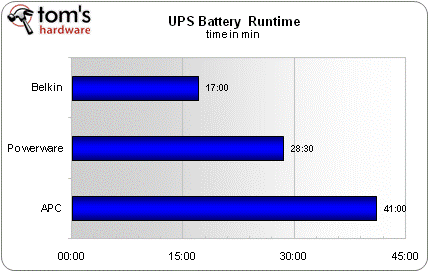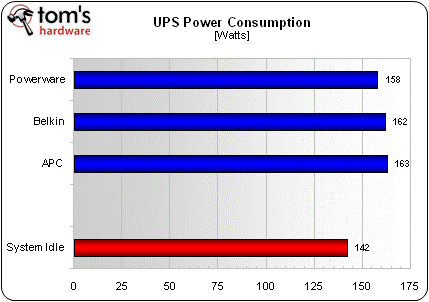UPSes To The Rescue
Test Results
Battery Runtime
The battery capacity of the different UPS devices varies. Belkin offers the least power at 5 Ah; Eaton offers 7 Ah per battery pack and APC includes 9 Ah batteries, which explains the difference. As our test system consumed approximately 142 W, you can easily calculate the run time at maximum load by dividing our results by 4.2, which is because 600 W is 4.2 times more than our 142 W load. Since we're talking about only four minutes with the Belkin UPS and roughly nine minutes with APC, you should quickly stop what you're doing and shutdown the system if your UPS starts beeping.
All UPS products require some power to operate, which we found was 16 W (Eaton/Powerware) to 21 W (APC).
Conclusion
The three entry-level UPS devices from APC, Belkin and Eaton/Powerware are tried-and-tested products that any user with a minimal level of experience installing hardware and software can setup and configure - even if this is your first contact with an uninterruptible power supply unit. Although connecting the power cables is simple, you might want to have a look at the manual before getting started - unfortunately, only APC provides decent hard copy documentation. Belkin and Eaton/Powerware require you to study the details electronically on a CD. .
All three products come with comprehensive software solutions, which allow the user to setup emergency procedures such as power outage notification via email and, of course, the shutdown sequence. APC's Smart-UPS is based on a serial port for management purposes, but includes a COM-to-USB adapter. Belkin and Eaton/Powerware can be hooked up with a USB connection. The software typically is installed on the UPS client to provide the battery buffer; only APC's PowerChute software is split into several modules, allowing you to install the controller program on a client system for network management. More-sophisticated UPS products will have their own network interface to do this, and we do not consider network management options to be really important for desktop/workstation/media server use. Once you have configured your desired shutdown and resume schedule, all three systems do an excellent job.
While the three products can provide 600 W or slightly more wattage (and will shutdown quickly if the output is exceeded), the battery capacities differ a lot. Our test system consumed an idle power of 142 W, which gave us a 41-minute battery runtime with the APC Smart-UPS SC, almost 29 minutes with Eaton's Powerware 5115 and 17 minutes with the Belkin F6C1000ei. Clearly, the APC unit is best suitable for a SMB or media server, which you probably do not want to shutdown immediately. A battery runtime of 40 minutes is sufficient to bridge many unexpected power outages. Eaton/Powerware and Belkin in particular provide the better desktop UPS solutions, which are meant to give you just as much time to save your work, terminate applications and shutdown your system. The batteries should still have enough energy to keep your phone or phone system on line for awhile, as well. Belkin provides more power jacks and two surge-protected power ports, while Eaton/Powerware offers the highest maximum power output. Unfortunately, the Powerware unit doesn't work as quietly as the Belkin device, and it costs more than twice as much.
Join our discussion on this topic
Get Tom's Hardware's best news and in-depth reviews, straight to your inbox.

Patrick Schmid was the editor-in-chief for Tom's Hardware from 2005 to 2006. He wrote numerous articles on a wide range of hardware topics, including storage, CPUs, and system builds.

